This page is based on this
Wikipedia article Text is available under the
CC BY-SA 4.0 license; additional terms may apply.
Images, videos and audio are available under their respective licenses.
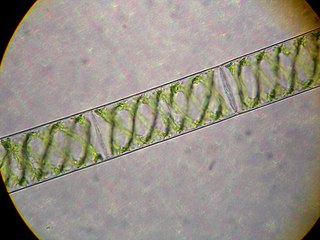
Spirogyra is a genus of filamentous charophyte green algae of the order Zygnematales, named for the helical or spiral arrangement of the chloroplasts that is characteristic of the genus. It is commonly found in freshwater habitats, and there are more than 400 species of Spirogyra in the world. Spirogyra measures approximately 10 to 100 μm in width and may grow to several centimetres in length.
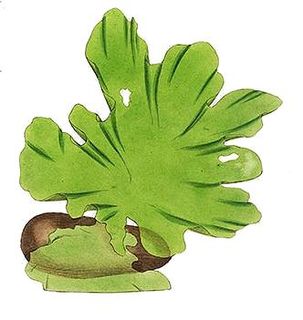
The sea lettuces comprise the genus Ulva, a group of edible green algae that is widely distributed along the coasts of the world's oceans. The type species within the genus Ulva is Ulva lactuca, lactuca being Latin for "lettuce". The genus also includes the species previously classified under the genus Enteromorpha, the former members of which are known under the common name green nori.

Oscillatoria is a genus of filamentous cyanobacterium which is named after the oscillation in its movement. Filaments in the colonies can slide back and forth against each other until the whole mass is reoriented to its light source. It is commonly found in watering-troughs waters, and is mainly blue-green or brown-green. Oscillatoria is an organism that reproduces by fragmentation. Oscillatoria forms long filaments of cells which can break into fragments called hormogonia. The hormogonia can grow into a new, longer filament. Breaks in the filament usually occur where dead cells (necridia) are present. Oscillatoria uses photosynthesis to survive and reproduce. Each filament of oscillatoria consists of trichome which is made up of rows of cells. The tip of the trichome oscillates like a pendulum.
in reproduction, it takes place by vegetative means only. Usually the filament breaks into a number of fragments called homohonia. Each hormogonium consist of one or more cells and grow into a filament by cell division in one direction.

Porphyra is a coldwater seaweed that grows in cold, shallow seawater. More specifically, it belongs to red algae phylum of laver species, comprising approximately 70 species. It grows in the intertidal zone, typically between the upper intertidal zone and the splash zone in cold waters of temperate oceans. In East Asia, it is used to produce the sea vegetable products nori and gim. There are considered to be 60 to 70 species of Porphyra worldwide and seven around Britain and Ireland where it has been traditionally used to produce edible sea vegetables on the Irish Sea coast. Porphyra is a chief source of plant-based vitamin B12.

Codium is a genus of seaweed in the Chlorophyta of the order Bryopsidales. There are about 50 species worldwide.

Chordariaceae is a family of brown algae. Members of this family are may be filamentous, crustose with fused cells at the base, or they may be terete and differentiated into a central medulla and an outer photosynthetic cortex. They have a sporphytic thallus usually aggregated to form a pseudo-parenchyma.

Quo primum is the incipit of an Apostolic constitution in the form of a papal bull issued by Pope Pius V on 14 July 1570. It promulgated the 1570 edition of the Roman Missal, and made its use obligatory throughout the Latin Rite of the Catholic Church, except where there existed a different Mass liturgy of at least two hundred years' standing.
Cruoriopsis is a genus of red algae. It has sometimes been considered a synonym of Cruoriella Crouan & Crouan or part of the large genus Peyssonnelia. A 2007 dissertation by Krayesky recognizes this genus, as does ITIS.
Halymenia a genus of a macroscopic red algae that grows in oceans worldwide. It includes the following species:
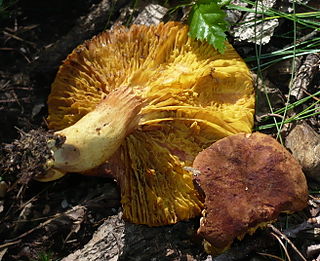
Phylloporus pelletieri, commonly known as the golden-gilled bolete, is a species of fungus in the Boletaceae family.
Ascophanus is a genus of fungi in the Ascobolaceae family. The genus has a widespread distribution, and contains 20 species, most of which grow on dung.
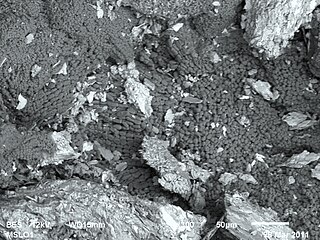
Lithophyllum is a genus of thalloid red algae belonging to the family Corallinaceae.

Laurencia is a genus of red algae that grow in temperate and tropical shore areas, in littoral to sublittoral habitats, at depths up to 65 m (213 ft).
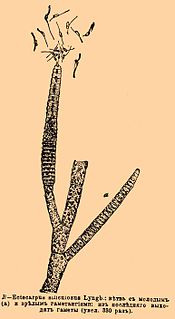
Ectocarpus is a genus of filamentous brown alga (Heterokontophyta) that is a model organism for the genomics of multicellularity. Among possible model organisms in the brown algae, Ectocarpus was selected for the relatively small size of its mature thallus and the speed with which it completes its life cycle. The type species for the genus is Ectocarpus siliculosus (Dillwyn) Lyngbye.

Rivularia is a genus of cyanobacteria of the family Rivulariaceae.
Cruoriella is a genus of red algae in the family Peyssonneliaceae.

Polysiphonia ceramiaeformis, also called banded siphon weed, is a small red algae (Rhodophyta), in the genus Polysiphonia. Individuals are irregularly branched with the branches extending up to 5.5 centimetres (2.2 in) from a central node and ending in dense tufts of fibres.

Phyllophora is a genus of red algae in the family Phyllophoraceae.

Dictyota is a genus of seaweed in the Dictyotaceae family. Species are predominantly found in tropical and sub-tropical seas, and are known to contain numerous chemicals (diterpenes) which have potential medicinal value. As at the end of 2017, some 237 different diterpenes had been identified from across the genus.















